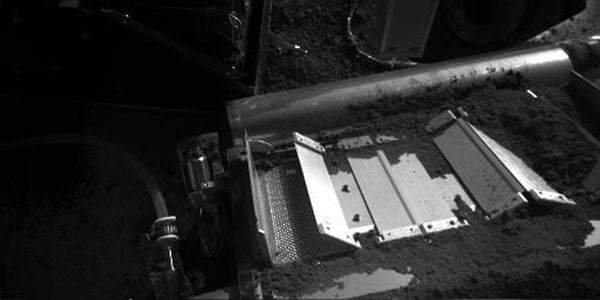NASA’s Phoenix Mars Lander has scooped up a soil sample from an intermediate depth between the ground surface and a subsurface icy layer. The sample was delivered to a laboratory oven on the spacecraft.
The robotic arm on Phoenix collected the sample, dubbed “Burning Coals,” from a trench named “Burn Alive 3.” The sample consisted of about one-fourth to one-half teaspoon of loose soil scooped from a depth of about 1.2 inches (3 centimeters) below the surface of the ground and about 0.4 inch (1 centimeter) above a hard, icy underground layer.
Data received from Phoenix early Thursday confirmed that the arm had delivered some of that sample through the doors of cell 7 on the lander’s Thermal and Evolved Gas Analyzer (TEGA) and that enough material passed through a screen and down a funnel to nearly fill the cell’s tiny oven. The Phoenix team prepared commands Thursday to have TEGA close the oven and begin heating the sample to low temperature (95° Fahrenheit [35° Celsius]).
The purpose of the low temperature heating is to look for ice in the sample. The next step is a middle temperature process, which heats the sample to 257° F (125° C) to thoroughly dry the sample. The last heating takes the sample to 1832° F (1000° C). The gases given off during these heating stages help the science team to determine properties of the martian soil.
“We are expecting the sample to look similar to previous samples,” said William Boynton of the University of Arizona, lead scientist for TEGA. “One of the things we’ll be looking for is an oxygen release indicative of perchlorate.”
Perchlorate was found in a sample delivered to Phoenix’s Microscopy, Electrochemistry, and Conductivity Analyzer (MECA). The MECA team saw the perchlorate signal in a sample taken from a trench called “Dodo-Goldilocks” on June 25, and again in another sample taken from the “Rosy Red” trench on July 6. To see signs of perchlorate in TEGA would help confirm the previous results. Scientists are analyzing data from a Rosy Red surface sample heated in TEGA cell number 5 last week.
The new sample in cell 7 completes a three-level soil profile that also includes the surface material (from Rosy Red) and ice-layer material (from a trench called “Snow White”).
“We want to know the structure and composition of the soil at the surface, at the ice and in-between to help answer questions about the movement of water — either as vapor or liquid — between the icy layer and the surface,” said Ray Arvidson of Washington University in St. Louis, a leader of Phoenix science team activities.










